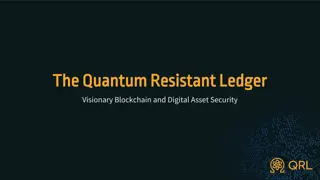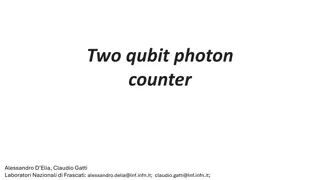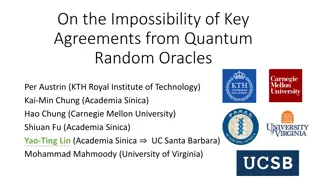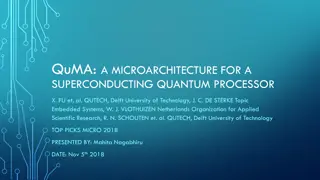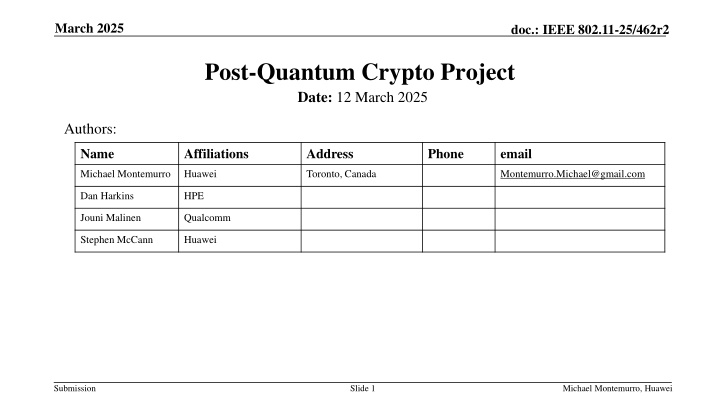
IEEE 802.11-25/462r2 Post-Quantum Crypto Project Update
Explore the implications of quantum computing on current public key cryptography standards and the urgent need to prepare for a post-quantum future in IEEE 802.11 networks. The document discusses the potential risks posed by quantum computers, the formation of a study group to enhance WLAN security with post-quantum algorithms, and the importance of updating existing standards to be resilient to cryptographically relevant post-quantum threats.
Download Presentation

Please find below an Image/Link to download the presentation.
The content on the website is provided AS IS for your information and personal use only. It may not be sold, licensed, or shared on other websites without obtaining consent from the author. If you encounter any issues during the download, it is possible that the publisher has removed the file from their server.
You are allowed to download the files provided on this website for personal or commercial use, subject to the condition that they are used lawfully. All files are the property of their respective owners.
The content on the website is provided AS IS for your information and personal use only. It may not be sold, licensed, or shared on other websites without obtaining consent from the author.
E N D
Presentation Transcript
March 2025 doc.: IEEE 802.11-25/462r2 Post-Quantum Crypto Project Date: 12 March 2025 Authors: Name Affiliations Address Phone email Michael Montemurro Huawei Toronto, Canada Montemurro.Michael@gmail.com Dan Harkins HPE Jouni Malinen Qualcomm Stephen McCann Huawei Submission Slide 1 Michael Montemurro, Huawei
March 2025 doc.: IEEE 802.11-25/462r2 Post-Quantum Cryptography Today all of our public key crypto is based on two hard problems: Factoring large numbers Discrete logarithm problem Our secure systems would become insecure if one (or both) of those were broken A quantum computer, which does not exist yet, will be able to break both of these Such a computer will exist in the (very near) future In 802.11, public key crypto is used in AKM suites, but not in cipher suites. We need to plan today for a post-quantum future with 802.11 because it takes many years to deploy new technology in the field Submission Slide 2 Michael Montemurro, Huawei
March 2025 doc.: IEEE 802.11-25/462r2 Mosca Theorum There is a 1 in 7 chance that some fundamental public-key crypto will be broken by quantum by 2026, and a 1 in 2 chance of the same by 2031. Dr. Michele Mosca, (April 2015) If encrypted data needs to be safe for X years; and, If it takes Y years to deploy a post-quantum solution; and, If a post-quantum computer will exist in Z years Then if (X + Y) > Z you need to worry time Y X Z Submission Slide 3 Michael Montemurro, Huawei
March 2025 doc.: IEEE 802.11-25/462r2 Post-Quantum crypto and IEEE 802.11 Currently there is no work in IEEE 802.11 to address this issue. There is active work in NIST as well as other organizations such as IETF. Propose to start a project with the objective to update WLAN security to be resilient to a cryptographically relevant post-quantum computer. At a high level, the scope of the new project would cover: Updating or creating new AKMs to be more resilient to quantum computing. Looking into updates in other areas of IEEE 802.11 where public key cryptography is used (e.g. SAE, OWE, AP PeerKey, FILS, or PASN) Submission Slide 4 Michael Montemurro, Huawei
March 2025 doc.: IEEE 802.11-25/462r2 Post-Quantum Crypto SG formation Request approval by the IEEE 802 LMSC to form an 802.11 Post-Quantum Cryptography PAR Study Group to enhance WLAN security with post-quantum algorithms as described in doc 11-24/1103r1, with the intent of creating a PAR and CSD. Moved: <name>, Seconded: <name> Result: Yes: xx, No: xx, Abstain: xx (Motion passes/fails) Submission Slide 5 Michael Montemurro, Huawei

